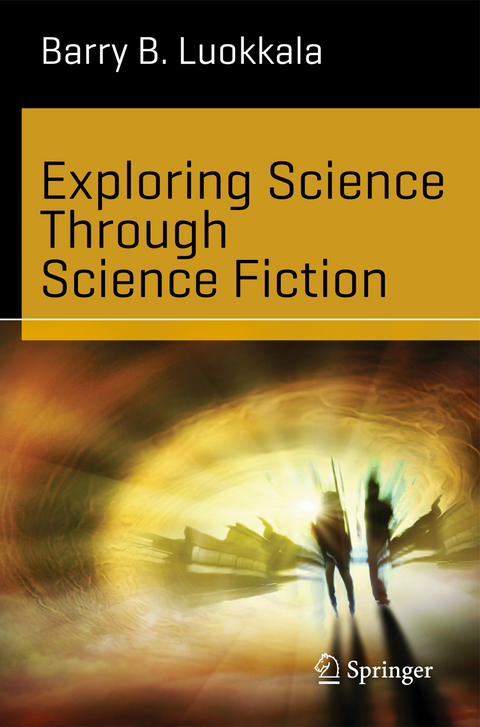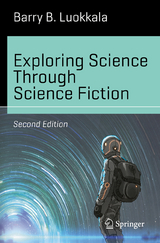Exploring Science Through Science Fiction
Springer-Verlag New York Inc.
978-1-4614-7890-4 (ISBN)
The material in this book forms the basis of an interdisciplinary, college-level course, which uses science fiction film as a vehicle for exploring science concepts. Unlike traditional introductory-level courses, the science content is arranged according to major themes in science fiction, with a deliberate progression from the highly objective and discipline-specific (e.g. Reference Frames; Physics of Space Travel and Time Travel) to the very multi-disciplinary and thought-provoking (e.g. Human Teleportation; Science and Society). Over 100 references to science fiction films and television episodes are included, spanning more than 100 years of cinematic history. Some of these are conducive to calculations (solutions included).
Barry Luokkala is a teaching professor and director of undergraduate laboratories in the department of physics at Carnegie Mellon University. He received his BS and MS degrees in physics at the University of Pittsburgh, where he did experimental research in the physics and chemistry of the ionosphere. He received his PhD in experimental condensed matter physics at Carnegie Mellon University. He has also served as program director for the Pennsylvania Governor’s School for the sciences and has been a science consultant for the Sloan Foundation Screenplay Competition in Carnegie Mellon’s School of Drama.
Preface.- 1 Introduction: Discerning the Real, the Possible and the Impossible.- 1.1 The first sci-fi movie.- 1.1.1 exploring the science in Le Voyage dans la Lune.- 1.2 The first literary work of science fiction.- 1.3 Reference frames, revisited.- 1.4 Roadmap to the rest of the book.- 2 What is the Nature of Space and Time? (the physics of space travel and time travel).- 2.1 Changing perspectives through history.- 2.2 Newton’s Laws.- 2.3 Einstein and relativity.- 2.3.1 special relativity and time dilation.- 2.3.2 general relativity and distortion of spacetime.- 2.3.3 gravitational waves.- 2.3.4 faster than light, but not faster than light.- 2.4 Stephen Hawking, black holes, wormholes and quantum gravity.- 2.4.1 black holes.- 2.4.2 the multiverse hypothesis.- 2.4.3 wormholes.- 2.5 Other time travel scenarios.- 3 What is the Universe Made of? (matter, energy and interactions).- 3.1 The Standard Model of Particle Physics.- 3.2 The atomic nucleus: protons, neutrons, isotopes and radioactivity.- 3.3 Gases.- 3.4 Solid state materials.- 3.5 Phase transitions.- 3.6 Transparency and invisibility: optical properties of materials.- 3.6.1 transparent solids.- 3.6.2 camouflage.- 3.6.3 stealth technology.- 3.6.4 metamaterials and cloaking.- 3.7 Energy and power.- 3.7.1 kinetic and potential energy.- 3.7.2 chemical energy.- 3.7.3 distinguishing between power and energy.- 3.7.4 nuclear energy.- 3.7.5 matter-antimatter annihilation.- 4 Can a Machine Become Self-Aware? (the sciences of computing and cognition).- 4.1 Computer hardware performance specifications.- 4.2 Analog computers.- 4.3 Digital computers.- 4.4 Beyond digital computers.- 4.5 Information storage.- 4.6 Robotics.- 4.7 Robot behavior.- 4.8 Toward the creation of artificial consciousness.- 5 Are We Alone in the Universe? (the search for extraterrestrial intelligence).- 5.1 Major considerations.- 5.2 Searching for ET: government agency or private industry?.- 5.3 Listening for ET: what form of communication might we expect?.- 5.4 Conditions necessary for intelligent life to arise.- 5.4.1 the origin and diversity of life on Earth.- 5.5 Cinema and the science of the SETI project.- 5.6 Where might first contact occur and how will humans and aliens interact?.- 6 What does it Mean to be Human? (biological sciences, biotechnology and other considerations).- 6.1 Bodies with replaceable parts.- 6.2 Resistance to disease.- 6.3 Cell structure and radiation damage.- 6.3.1 detection of ionizing radiation.- 6.3.2 biological effects of exposure to ionizing radiation.- 6.3.3 UV radiation and skin cancer.- 6.4 DNA and the human genome.- 6.4.1 DNA sequencing and genetic engineering.- 6.5 Cloning.- 6.6 Human teleportation.- 6.6.1 the problem of duplication.- 6.6.2 getting all the + and – signs in the right place.- 6.6.3 the uncertainty principle: limitations on precision of quantum measurement.- 6.7 Teleportation estimations.- 6.8 Beyond biology.- 6.9 What can we learn from an android about what it means to be human?.- 7 How do We Solve Our Problems? (science, technology and society).- 7.1 The public perception of science and scientists.- 7.1.1 science as obsession.- 7.1.2 science and arrogance.- 7.1.3 science as an act of futility.- 7.1.4 the model scientist.- 7.2 The methodology of science.- 7.3 Science, pseudoscience and nonsense.- 7.4 Problems to be solved.- 7.4.1 How can we increase public awareness of science?.- 7.4.2 How do we respond to threats or attacks?.- 7.4.3 How can we feed the hungry?.- 7.4.4 How can we conserve our natural resources?.- 7.4.5 How can an unstable government avoid total collapse?.- 7.4.6 How can we provide better healthcare?.- 7.4.7 How can a company sell more products?.- 7.4.8 How do we establish justice?.- 8 What Lies Ahead? (the future of our technological society).- 8.1 Accurate predictions.- 8.1.1 space and time.- 8.1.2 matter and energy.- 8.1.3 robotics.- 8.1.4 planets in other star systems.- 8.1.5 biomedical technology.- 8.1.6 communication technology.- 8.1.7 brain-computer interfacing.- 8.2 Coming soon: possibilities for the not-so-distant future.- 8.2.1 space exploration.- 8.2.2 dark matter and dark energy.- 8.2.3 real adaptive camouflage.- 8.2.4 room-temperature superconductivity.- 8.2.5 quantum computers.- 8.2.6 robots in the home.- 8.2.7 cybernetic devices.- 8.2.8 artificial heart.- 8.3 Science fiction in historical context.- 8.3.1 The Island of Dr. Moreau.- 8.3.2 The War of the Worlds.- 8.3.3 The Day the Earth Stood Still.- 8.4 Visions of the future.- 8.4.1 defining culture in terms of technology.- 8.4.2 social divisions.- 8.4.3 technophiles and technophobes.- 8.4.4 turning over too much control to technology.- 8.4.5 the rise of AI.- 8.4.6 what is real?.- 8.4.7 sentient VR characters.- 8.4.8 civilization destroyed by its own technology.- 8.5 Responsible technology.- Appendix A: Catalog of Movies Cited.- Appendix B: Catalog of Television Series Episodes Cited.- Appendix C: Catalog of YouTube Videos Cited.- Appendix D: Solutions to Estimation Problems.
“Exploring Science Through Science Fiction. A spark from a class at Carnegie Mellon gave birth to this book of great depth and breadth in the world of science and various fiction surrounding it. It offers a great look into the known and unknown and is sure to make you think.” (Christian Pavlovich, Film Matters, Vol. 9 (1), 2018)
“Barry B. Luokkala’s Exploring Science Through Science Fiction offers a wide-ranging treatment of fundamental scientific questions and concepts as dramatized in science fiction. Designed for an undergraduate science course, this textbook addresses the varying degree of plausibility inherent to many popular science fiction constructs … . Exploring Science through Science Fiction strikes a delicate compromise, introducing readers to the fantastical side of science without being completely overwhelming.” (Jen Jenkins, Journal of Science Fiction, Vol. 2 (1), September, 2017)“Exploring Science through Science Fiction fits into a lineage of works that use science fiction as a starting point for science education. … The book is very clear and well written. … the book is a good text for an optional one-semester undergraduate course, but it can also be used as a source of ideas for sci-fi illustrations of particular points in any core science course, even at high school level. … I highly recommend this book.” (Jerzy Brzozowski, Science and Education, Vol. 25, 2016)“Luokkala has recognized the usefulness of this bridging of the arts and sciences in the classroom, and his textbook … comes out of more than a decade of teaching an undergraduate course on this topic. … it provides an engaging introduction to scientific thinking. The proposed discussion topics may indeed work best in a mixed classroom, in which students will be able to learn how views on the topic under discussion may differ between scientists and non-scientists.” (Kanta Dihal, Foundation, Vol. 122, 2015)“The author presents many good discussion and exploration topics, as well as back-of-the-envelope-type estimation problems. The references include DVD release and scene number information, making the chapter and end-of-book bibliographies highly valuable to instructors interested in bringing such subject material into their classroom. Summing Up: Recommended. All undergraduate students, faculty, and general readers.” (S. A. Curtis, Choice, Vol. 51 (10), June, 2014)“Exploring Science Through Science Fiction is organized into seven chapters centered on common themes in science fiction film and literature … . this book is an engaging and readable text. … The textbook has the ability to spark in its readers an interest in and appreciation for science and technology. Luokkala provides ample resources in the appendices for interested readers to continue their own investigations.” (Emily Margolis, Quest The history of Spaceflight, Vol. 21 (3), 2014)
| Reihe/Serie | Science and Fiction |
|---|---|
| Zusatzinfo | 20 Illustrations, color; 7 Illustrations, black and white; XIX, 241 p. 27 illus., 20 illus. in color. |
| Verlagsort | New York, NY |
| Sprache | englisch |
| Maße | 155 x 235 mm |
| Gewicht | 4524 g |
| Themenwelt | Sachbuch/Ratgeber ► Natur / Technik |
| Naturwissenschaften ► Biologie | |
| Naturwissenschaften ► Physik / Astronomie ► Theoretische Physik | |
| Technik ► Luft- / Raumfahrttechnik | |
| Technik ► Maschinenbau | |
| Schlagworte | faster than light travel • human teleportation • origins of science fiction • physics for poets • physics of space travel • science fiction explained • science fiction technologies • science for jocks • the science of science fiction • transporter technology |
| ISBN-10 | 1-4614-7890-1 / 1461478901 |
| ISBN-13 | 978-1-4614-7890-4 / 9781461478904 |
| Zustand | Neuware |
| Haben Sie eine Frage zum Produkt? |
aus dem Bereich





